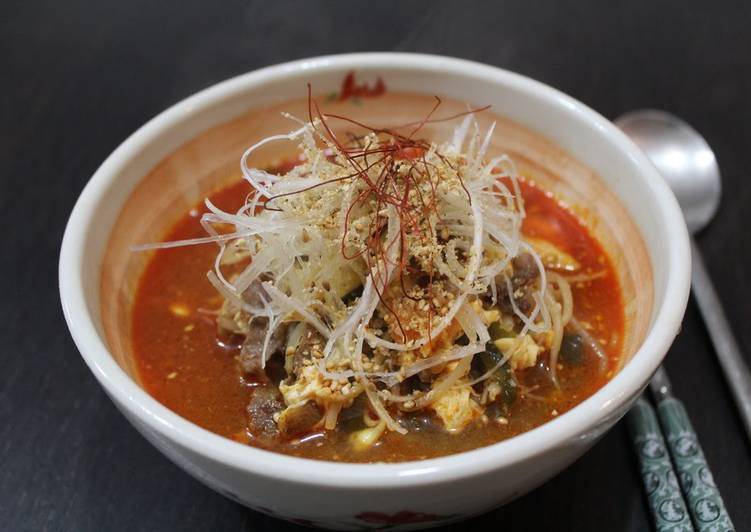
Hello everybody, it’s me, Dave, welcome to our recipe site. Today, I will show you a way to prepare a special dish, yukgaejang soup. One of my favorites. For mine, I’m gonna make it a bit tasty. This will be really delicious.
I'm re-introducing the delicious and nutritious yukgaejang to you today: spicy beef and vegetable soup. This soup is smoky, spicy, and rich, with healthy hunks of sliced beef and plenty of vegetables that are soft, but not mushy—they're full of earthy mountain flavor from gosari (fernbrake). Yukgaejang (육개장) is a hearty, spicy beef soup that's highly popular in Korea.
Yukgaejang Soup is one of the most popular of current trending meals on earth. It’s enjoyed by millions daily. It is easy, it’s quick, it tastes yummy. They are fine and they look wonderful. Yukgaejang Soup is something which I’ve loved my whole life.
To begin with this recipe, we have to first prepare a few ingredients. You can have yukgaejang soup using 16 ingredients and 8 steps. Here is how you cook that.
The ingredients needed to make Yukgaejang Soup:
- Prepare 200 grams Beef (flank or cut offs)
- Get 1 1/2 tbsp for moderate spice Dadaegi (Korean flavored chili paste)
- Prepare 1 tsp Sesame oil
- Take 1 bag Bean sprouts
- Get 1 Japanese leek
- Get 1/2 pack Enoki mushrooms
- Take 1/2 packet Shimeji mushrooms
- Make ready 1 tbsp ☆ Soy sauce
- Prepare 1 tsp ☆ Sugar
- Prepare 1 tsp ☆ Salt
- Make ready 1 tbsp ☆ Dashi or dashida
- Prepare 1 ☆ Pepper
- Take 2 Eggs
- Get 1 Sesame seeds
- Prepare 1000 ml Water
- Prepare 1 Chilli threads or green onion (if you have them)
The classic traditional Yukgaejang soup recipe consists of brisket meat, Gosari (Bracken Fiddleheads) in addition to lots of green onions, bean sprouts and eggs. Yukgaejang is a spicy, Korean soup dish made from beef brisket, scallions, and a whole host of other ingredients. It is considered very healthful and is a great comfort during cold months. In addition to shredded beef, scallions, and water,.
Instructions to make Yukgaejang Soup:
- Firstly, make plenty of dadaegi by checking out. The more, the better. - - https://cookpad.com/us/recipes/170783-dadaegi-korean-spicy-sesame-chili-oil-like-ra-yu
- Cut the beef into thin slices. Rinse the bean sprouts well and cut away any parts that are going bad as well as any membranes. Chop the green part of the green onion into diagonal slices.
- Cut away the tough stems of the mushrooms and chop into bite-sized pieces.
- Add some oil to a large pan and stir-fry the beef. When the beef has browned, add the dadaegi and stir together.
- Once well mixed, add the rest of the vegetables and stir-fry while continuing to mix.
- Add 1 litre of water plus the seasonings marked with ☆. Skim away any scum and heat the mixture for 10 minutes while gently simmering. Taste and add salt, if necessary.
- If you want to make the soup even more spicy, then feel free to add some Korean chilli powder. Or you could even increase the amount of dadaegi….
- Lastly, whisk in a beaten egg and turn off the heat. Pour the soup into dishes and serve with green onions and sesame seeds or a sprinkling of chilli threads.
Yukgaejang (육개장, 肉개醬) or spicy beef soup is a spicy, soup-like Korean dish made from shredded beef with scallions and other ingredients, which are simmered together for a long time. It is a variety of gomguk, or thick soup, which was formerly served in Korean royal court cuisine. It is thought to be healthful and is popular due to its hot and spicy nature. Yukgaejang is one of the dishes Koreans eat to regain stamina during the summer. But it's also great for winter, especially when you have a cold.
So that is going to wrap it up for this exceptional food yukgaejang soup recipe. Thank you very much for reading. I’m sure you can make this at home. There is gonna be interesting food at home recipes coming up. Don’t forget to save this page on your browser, and share it to your loved ones, colleague and friends. Thanks again for reading. Go on get cooking!


